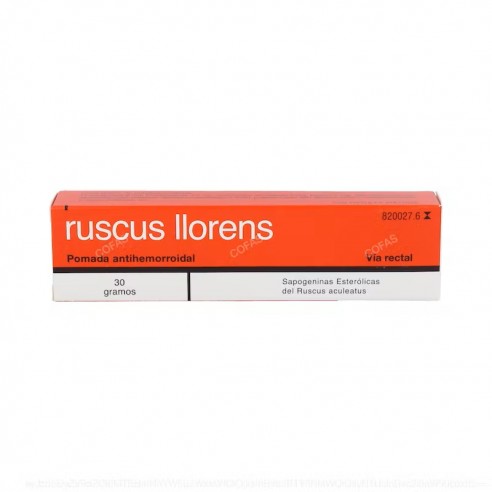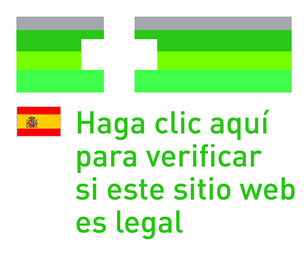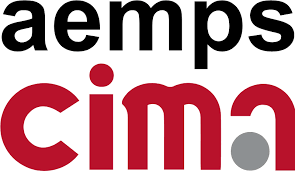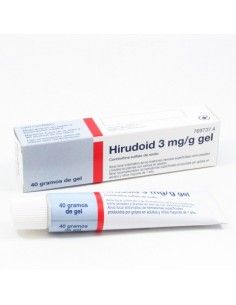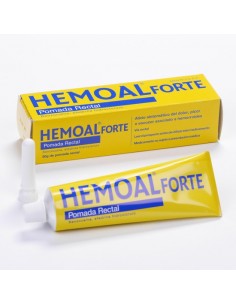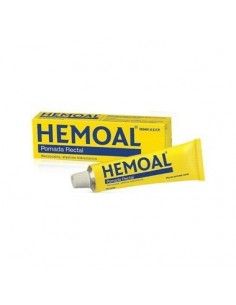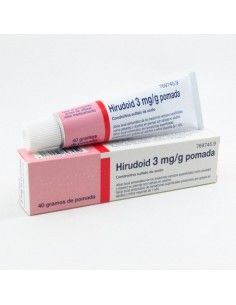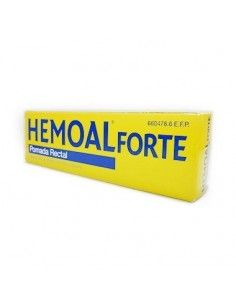1. What is Ruscus Llorens and what is it used for?
Ruscus Llorens rectal ointment belongs to the group of topical medicines for the treatment of haemorrhoids, which contain corticosteroids. It contains active ingredients that help to relieve the symptoms of haemorrhoids: prednisolone, a corticosteroid with anti-inflammatory activity; ruscogenin, which tones blood vessels and prevents clot formation; cinchocaine, a local anaesthetic for pain; zinc oxide, which protects the skin; and levomenthol, to relieve itching.
Ruscus Llorens is indicated for the local symptomatic treatment of anorectal inflammation and anal itching (pruritus) associated with haemorrhoids in adults.
2. What you need to know before you start using Ruscus Llorens
Do not use Ruscus Llorens:
If you are allergic to prednisolone, ruscogenin, cinchocaine hydrochloride, zinc oxide or levomenthol, or to any of the other ingredients of this medicine (listed in section 6).
If you have bleeding haemorrhoids.
If you have bacterial (e.g. tuberculosis), viral (e.g. herpes) or fungal infections in the area to be treated.
Warnings and precautions
Consult your doctor or pharmacist before starting to use Ruscus Llorens.
- In case of irritation at the site of application, the use of the ointment should be discontinued and, if necessary, appropriate treatment should be prescribed by a doctor.
- Avoid contact with the eyes or around the eyes and other mucous membranes (e.g. mouth).
- The application of corticosteroids over large areas, prolonged use, or with occlusive dressing or nappies, may result in effects on other parts of the body than the area to be treated (such as involvement of glands next to the kidneys, with symptoms of Cushing's syndrome - characterised by rounded face, accumulation of fat, delayed healing, etc. - high blood pressure, etc.), due to the increased amount absorbed.
- If you have an infection in the area to be treated, consult your doctor beforehand, who will indicate a specific treatment. If there is no rapid improvement, treatment should be discontinued until the infection has been controlled.
- Contact your doctor if you have blurred vision or other visual disturbances.
- Caution should be exercised in the elderly and in patients with weakened or damaged mucous membranes, as they may be more sensitive to systemic adverse effects (due to absorption of the active substances into the body).
Use in athletes
This medicine contains a component, prednisolone (glucocorticoid), which may produce a positive result in doping control tests.
Children and adolescents
Do not administer to children under 18 years of age.
Other medicines and Ruscus Llorens
Tell your doctor or pharmacist if you are taking, have recently taken or may take any other medicines.
Do not apply other products at the same time as this medicine.
Pregnancy, breast-feeding and fertility
If you are pregnant or breast-feeding, think you may be pregnant or intend to become pregnant, consult your doctor or pharmacist before using this medicine.
The use of Ruscus Llorens ointment during pregnancy should be reserved for cases where the therapeutic benefit outweighs the possible risk.
Your doctor will decide whether it is necessary to interrupt breast-feeding or discontinue treatment with Ruscus Llorens after considering the benefit of breast-feeding for the child and the benefit of treatment for the mother.
Driving and use of machines
The use of this medicine does not affect the ability to drive or use machines.
Ruscus Llorens contains parahydroxybenzoate esters and cetyl alcohol.
It may cause allergic reactions (possibly delayed) because it contains methyl parahydroxybenzoate (E-218), ethyl parahydroxybenzoate (E-214), propyl parahydroxybenzoate (E-216), isobutyl parahydroxybenzoate and butyl parahydroxybenzoate.
This medicinal product may cause local skin reactions (such as contact dermatitis) because it contains cetyl alcohol.
3. How to use Ruscus Llorens
Follow exactly the instructions for use given in this leaflet or as directed by your doctor or pharmacist. If in doubt, ask your doctor or pharmacist.
Cutaneous and/or rectal use.
For adults:
Applications are recommended after bowel movements and personal cleanliness.
Before application, the affected area should be carefully washed with lukewarm water and mild soap and dried. Then apply an amount of ointment the size of 1 or 2 peas (equivalent to 0.5 - 1 cm) to the anal and/or rectal area with a clean gauze pad once or twice a day.
In case of internal haemorrhoids, use the cannula supplied with the pack by screwing it onto the tube and inserting the tip into the anus. Then apply a small amount of ointment (1 - 2 cm) by exerting light pressure on the tube. The cannula will be slowly withdrawn as the contents are emptied.
Ruscus Llorens should not be used for more than 7 days.
If symptoms worsen or persist after 7 days, you should consult your doctor or pharmacist.
If you use more Ruscus Llorens than you should
Excessive use of topical corticosteroids (repeated overdoses) may cause adverse effects (see section 4).
In case of accidental ingestion of the contents of the tube, symptoms such as vomiting, diarrhoea, dizziness, among others, may occur. It is recommended to drink plenty of water or other aqueous liquid and to treat symptomatically.
In case of overdose or accidental ingestion, consult your doctor or pharmacist immediately or call the Toxicological Information Service, telephone 91 562 04 20, or go to a medical centre indicating the medicine and the quantity taken.
If you forget to use Ruscus Llorens
Do not use a double dose to make up for a forgotten dose.
If you forget to use the rectal ointment at the scheduled time, apply it as soon as possible and continue as usual.
If you have any other questions about the use of this medicine, ask your doctor or pharmacist.
4. Possible side effects
Like all medicines, this medicine may cause side effects, although not everybody gets them.
At the recommended doses, local application as recommended is rarely associated with the occurrence of systemic (to areas other than the area of application) side effects.
In isolated cases, local adverse reactions may occur mainly due to hypersensitivity to the preparation, including sensitivity to sunlight (photosensitivity), especially when used on large areas of skin or in prolonged treatment.
Burning, itching, irritation, dryness, allergic contact dermatitis, skin maceration (softening), etc. may occur in the area around the anus.
If any of the above adverse reactions occur, discontinue treatment and consult your doctor or pharmacist.
Other side effects may also occur with topical corticosteroids, as one of the ingredients of this medicine:
Infrequently (may affect up to 1 in 100 people): blurred vision.
Frequency not exactly known from available data, especially with treatment over large areas or with occlusive dressing: skin infection; skin atrophy, dilatation of small blood vessels, skin striae, acne, redness, tingling of hands, feet or other areas, inflammation around the mouth (perioral dermatitis), changes in skin colour, cataracts, decreased heart rate.
Reporting side effects
If you experience any side effects, please tell your doctor or pharmacist, even if they are not listed in this leaflet. You can also report them directly to the Spanish Pharmacovigilance System for Medicinal Products for Human Use: https://www.notificaram.es. By reporting adverse effects you can help to provide more information on the safety of this medicine.
5. Storage of Ruscus Llorens
Keep out of the sight and reach of children.
Store in a refrigerator (between 2ºC and 8ºC).
Keep the container tightly closed to protect from light.
Do not use this medicine after the expiry date which is stated on the pack after EXP. The expiry date is the last day of the month indicated.
Medicines should not be flushed down the drain or thrown away. Please dispose of unneeded medicines and containers at the SIGRE Point at the pharmacy. If in doubt, ask your pharmacist how to dispose of packaging and medicines you no longer need. In this way, you will help to protect the environment.
6. Package contents and additional information
Composition of Ruscus Llorens
The active ingredients are: zinc oxide, prednisolone, ruscogenin, zinc hydrochloride and levomenthol. Each gram of ointment contains 100 mg zinc oxide (10%), 1.5 mg prednisolone (0.15%), 8 mg ruscogenin (0.8%), 5 mg cinchocaine hydrochloride (0.5%) and 2 mg levomentol (0.2%).
The other ingredients (excipients) are: macrogol 4000, macrogol 400, cetyl alcohol, edetate disodium, parahydroxybenzoate ester mixture (Nipastat®) (methyl parahydroxybenzoate (E218), ethyl parahydroxybenzoate (E214), propyl parahydroxybenzoate (E216), isobutyl parahydroxybenzoate, butyl parahydroxybenzoate) and purified water.
Appearance of the product and contents of the container
Ruscus Llorens is a white, semi-solid rectal ointment with a homogeneous appearance.
Each tube contains 30 grams of ointment, and includes a cannula for rectal application when appropriate.

